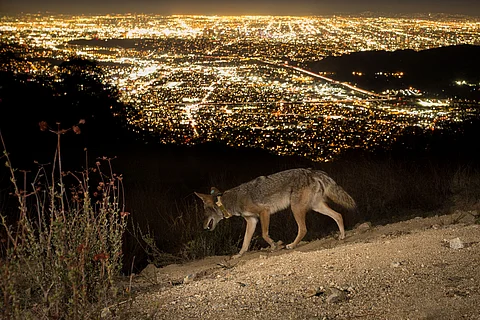

A new study by researchers has provided several key insights on how and why coyotes (Canis lupus latrans) are thriving in the megacity of Los Angeles, the second largest city in the United States.
They found that an area’s wealth, pollution, human population density, and other societal data points with information about regional landscapes and linear infrastructure—such as roads and railways—results in a more accurate prediction of where and how far a coyote will likely roam.
Twenty coyotes were trapped by the Los Angeles County Agricultural Commissioner’s office and outfitted with solar-powered GPS collars that reported their location at intervals ranging from 15 minutes to two hours.
“Information about a coyote’s habitat selection was calculated by analyzing GPS data and comparing that to the coyote’s movements in relation to the landscape. That information was combined with county-level geospatial information, census data, and metrics reported by CalEnviroScreen: a comprehensive statewide environmental health screening tool developed by the California Environmental Protection Agency,” according to a statement by the University of California, Berkeley.
It was found that roads, railways, and flood channels act as ‘movement corridors’ for coyotes rather than just barriers. For instance, coyotes generally had higher ‘step lengths’ in areas with higher road density, while coyotes in lower-income areas were more frequently found near railways than their counterparts in less-burdened areas.
The team also found that ecological landscape features—like the availability of water, vegetation, and habitat—are the best predictors of coyote movement and behaviour.
The wealth of a neighbourhood was also a factor in determining the presence of coyotes. This, according to the researchers, is contrary to the idea of the luxury effect, where wealthier areas tend to have higher levels of biodiversity due to their high-quality habitat and natural resources.
“When coyotes moved into those areas, the authors found that they moved more slowly than coyotes who live in poorer or more densely developed areas,” noted the statement by UC Berkeley.
According to the researchers, wealthier areas tend to have a more separationist and negative view toward coyotes, with a lot of people taking out permits to remove coyotes. This doesn’t happen in lower-income areas as it's very expensive to hire a trapper, they added.
The authors wrote that their work spotlighted how human-driven inequities affect environmental, wildlife, and human health.
As the human footprint continues to expand globally, the ultimate success of wildlife will rest on people’s ability to establish healthy, equitable, and functioning cities, as per the scientists.
Environmental Health and Societal Wealth Predict Movement Patterns of an Urban Carnivore has been published in the journal Ecology Letters. The authors are Christine E Wilkinson, Niamh Quinn, Curtis Eng and Christopher J Schell.